
The Palace Theatre is a West End theatre in the City of Westminster in London. Its red-brick facade dominates the west side of Cambridge Circus behind a small plaza near the intersection of Shaftesbury Avenue and Charing Cross Road. The Palace Theatre seats 1,400.

Music hall is a type of British theatrical entertainment that was most popular from the early Victorian era, beginning around 1850, through the Great War. It faded away after 1918 as the halls rebranded their entertainment as variety. Perceptions of a distinction in Britain between bold and scandalous music hall entertainment and subsequent, more respectable variety entertainment differ. Music hall involved a mixture of popular songs, comedy, speciality acts, and variety entertainment. The term is derived from a type of theatre or venue in which such entertainment took place. In North America vaudeville was in some ways analogous to British music hall, featuring rousing songs and comic acts.
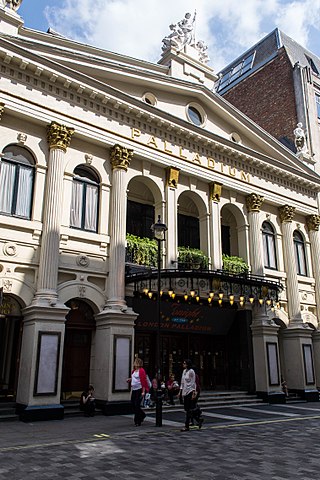
The London Palladium is a Grade II* West End theatre located on Argyll Street, London, in Soho. The theatre was designed by Frank Matcham and opened in 1910. The auditorium holds 2,286 people. Hundreds of stars have played there, many with televised performances. Between 1955 and 1969 Sunday Night at the London Palladium was staged at the venue, produced for the ITV network. The show included a performance by the Beatles on 13 October 1963; one newspaper's headlines in the following days coined the term "Beatlemania" to describe the hysterical interest in the band.

The Entertainments National Service Association (ENSA) was an organisation established in 1939 by Basil Dean and Leslie Henson to provide entertainment for British armed forces personnel during World War II. ENSA operated as part of the Navy, Army and Air Force Institutes. In 1946 it was re-named to Combined Services Entertainment (CSE) operating under the Services Sound and Vision Corporation (SSVC), until 2 March 2020, when the SSVC re-branded to the British Forces Broadcasting Service (BFBS), with the CSE likewise re-branding as BFBS Live Events.
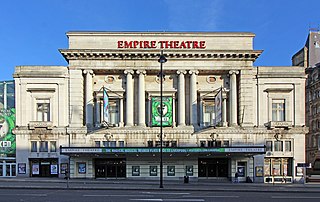
The Liverpool Empire Theatre is a theatre on the corner of Lime Street in Liverpool, England. The playhouse, which opened in 1925, is the second one to be built on the site. It has the largest two-tier auditorium in the United Kingdom and can seat 2,348 people.

The Cocoanuts is a 1929 pre-Code musical comedy film starring the Marx Brothers. Produced for Paramount Pictures by Walter Wanger, who is not credited, the film also stars Mary Eaton, Oscar Shaw, Margaret Dumont and Kay Francis. The first sound film to credit more than one director, it was adapted to the screen by Morrie Ryskind from the George S. Kaufman Broadway musical play. Five of the film's tunes were composed by Irving Berlin, including "When My Dreams Come True", sung by Oscar Shaw and Mary Eaton.
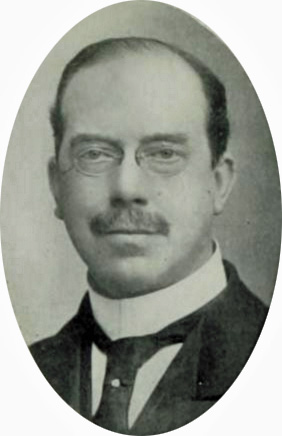
Sir Oswald Stoll was an Australian-born British theatre manager and the co-founder of the Stoll Moss Group theatre company. He also owned Cricklewood Studios and film production company Stoll Pictures, which was one of the leading British studios of the silent era. In 1912, he founded the Royal Variety Performance a now-annual charity show which benefits the Entertainment Artistes' Benevolent Fund.

Sir Horace Edward Moss was a British theatre impresario and the founder chairman and joint managing director of the Moss Empires Ltd theatre combine which he created in 1899, and floated on the Stock Exchange, after first joining forces with Richard Thornton of Newcastle and later with Oswald Stoll then operating in Wales. From its start and during the 20th century Moss Empires remained the largest group of variety theatres in Britain, with over 50 venues at its height, and was regarded as the largest in the world. It was he who, in 1904, introduced a "four shows a day" system at some of his theatres; he was also the first to allow advance booking of seats in a music hall.
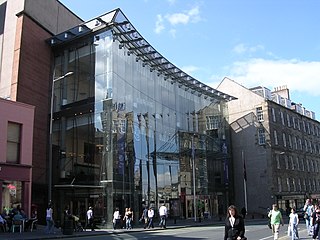
The Edinburgh Festival Theatre is a performing arts venue located on Nicolson Street in Edinburgh, Scotland. It is used primarily for performances of opera and ballet, large-scale musical events, and touring groups. After its most recent renovation in 1994, it seats 1,915. It is one of the major venues of the annual summer Edinburgh International Festival and is the Edinburgh venue for the Scottish Opera and the Scottish Ballet.
William Robert 'Bertie' Crewe was one of the leading English theatre architects in the boom of 1885 to 1915.
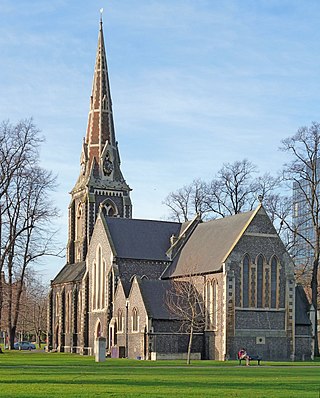
Turnham Green is a public park on Chiswick High Road, Chiswick, London, and the neighbourhood and conservation area around it; historically, it was one of the four medieval villages in the Chiswick area, the others being Old Chiswick, Little Sutton, and Strand-on-the-Green. Christ Church, a neo-Gothic building designed by George Gilbert Scott and built in 1843, stands on the eastern half of the green. A war memorial stands on the eastern corner. On the south side is the old Chiswick Town Hall.
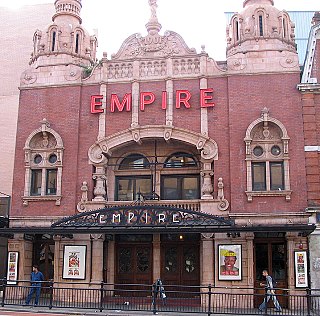
Hackney Empire is a theatre on Mare Street, in Hackney in the London Borough of Hackney. Originally designed by Frank Matcham it was built in 1901 as a music hall, and expanded in 2001. Described by The Guardian as "the most beautiful theatre in London" it is an Arts Council England National Portfolio Organisation.

Moss Empires was a company formed in Edinburgh in 1899, from the merger of the theatre companies owned by Sir Edward Moss, Richard Thornton and Sir Oswald Stoll. This created the largest chain of variety theatres and music halls in the United Kingdom. The business was successful, with major variety theatres in almost every city in the UK and Ireland, and was advertised as the largest group in the world.
Billy "Uke" Scott was a British music hall star, who inspired three generations of ukulele players, composing, singing and writing a "teach-yourself" ukulele manual.

Patricia Kirkwood was a British stage actress, singer and dancer who appeared in numerous performances of dramas, cabaret, revues, music hall, variety and pantomimes. She also performed on radio, television and films. In 1954, BBC Television broadcast The Pat Kirkwood Show; she was the first woman appearing on British television to have her own series.
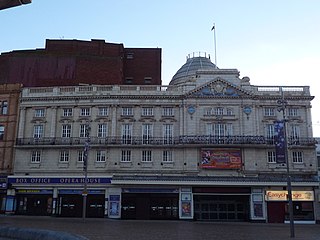
The Opera House Theatre is a theatre in Blackpool, Lancashire, England. It is located within the Winter Gardens, a large entertainment complex in the town centre and originally opened in 1889, although it has been rebuilt twice, in 1910 and 1939.

The Music Hall Strike of 1907 was a theatrical dispute which took place between music hall employees, stage artistes and London theatre proprietors. The catalyst for the strikes were the employees' lack of pay, the scrapping of perks, and an increase in working hours, and matinée performances.

The Hippodrome was a theatre in the town of Aldershot in Hampshire. It operated as a venue for variety shows, pantomimes, musical comedies and other shows from 1913 to 1961. When Peter Sellers appeared there in 1948 he complained that the band accompanying his drum act were four bars behind as they were eating their sandwiches while they were playing.

The Empress Theatre was an entertainment venue located on the corner of Bernay's Grove and Brighton Terrace in Brixton, south London from 1898 to 1992 when the building was demolished and the site redeveloped for housing.























